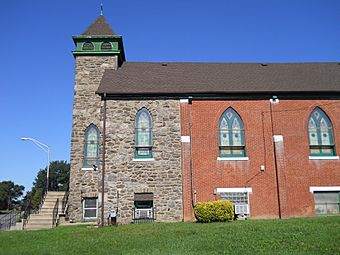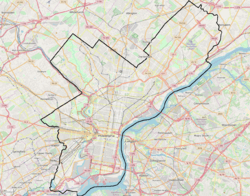Camptown Historic District facts for kids
Quick facts for kids |
|
|
Camptown Historic District
|
|

La Mott A M E Church
|
|
| Location | Roughly bounded by Penrose Ave., Graham Ln., Dennis St., and Cheltenham Ave., La Mott, Pennsylvania |
|---|---|
| Area | 26 acres (11 ha) |
| Architect | Multiple |
| Architectural style | Italianate, Gothic Revival, Other, Carpenter Gothic |
| NRHP reference No. | 85003434 |
| Added to NRHP | October 31, 1985 |
The Camptown Historic District is a special place in La Mott, Pennsylvania. It is also known as the La Mott Historic District or Camp William Penn. This area is famous for its important role in American history. It was once home to a well-known abolitionist and suffragette named Lucretia Mott.
The district was also a secret stop on the Underground Railroad. This was a network of safe houses that helped enslaved people escape to freedom. During the Civil War, it became a very important military training camp. From 1863 to 1865, it was home to Camp William Penn. This camp trained African-American soldiers who fought for the Union. After the war, many of these soldiers chose to buy homes and live in the area.
The district covers about 26 acres, which is like 20 football fields. It includes 35 important buildings that tell stories from the past. The area was first called "Camptown." However, because another town in Pennsylvania already had that name, it was renamed "La Mott" in 1885 when the post office opened. The Camptown Historic District was added to the National Register of Historic Places in 1985. This means it is officially recognized as a place with great historical importance.
Contents
Why is Camptown Historic District Important?
The Camptown Historic District holds many important stories from American history. It shows how people worked for freedom and equality. This area played a key role in the fight against slavery and for civil rights.
Lucretia Mott's Connection
One of the most famous people connected to this area is Lucretia Mott. She was a powerful voice for change in the 1800s.
- Abolitionist: Lucretia Mott was an abolitionist. This means she worked very hard to end slavery in the United States. She believed that all people should be free.
- Suffragette: She was also a suffragette. This means she fought for women's right to vote. At that time, women were not allowed to vote. Lucretia Mott believed in equal rights for everyone.
Her home in this district was a place where important ideas about freedom and justice were discussed.
A Stop on the Underground Railroad
The Camptown Historic District was a secret stop on the Underground Railroad. This was not a real railroad. Instead, it was a secret network of safe houses and routes. These routes helped enslaved African Americans escape from the Southern states to freedom in the North or Canada. People who helped were called "conductors." They risked their lives to guide freedom seekers. The district's role in this network shows its commitment to helping those seeking freedom.
Camp William Penn: Training African-American Soldiers
One of the most significant parts of the district's history is Camp William Penn.
- Civil War Role: During the American Civil War (1861-1865), this camp was a vital training ground. It was one of the first and largest camps for African-American soldiers.
- United States Colored Troops: These brave soldiers were part of the United States Colored Troops (USCT). They played a crucial role in the Union Army. Their service helped turn the tide of the war.
- Life After the War: After the Civil War ended, many of these soldiers chose to stay in the area. They bought homes and built new lives in what became the La Mott community. This created a strong, historic African-American community.
How the District Got Its Name
The area was first known as "Camptown" because of Camp William Penn. However, there was already another town in Pennsylvania with that name. To avoid confusion, the community was officially named "La Mott" in 1885. This name honors Lucretia Mott, recognizing her importance to the area.


